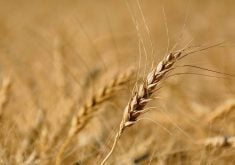Distributing a $90-million Canadian Grain Commission surplus through an additional cut in user fees can’t be tracked back to farmers, so the CGC wants to spend the money on measures that can, says assistant chief commissioner Doug Chorney.
“Expenditures of the funds that are collected in excess of our fees have to be used in a way that align with the mandate of the Canada Grain Act,” Chorney told the Keystone Agricultural Producers advisory council meeting here last week. “Producers and the grain sector must benefit from the investments and they must look at ways to modernize the way we operate.”
Read Also

Mazergroup’s Bob Mazer dies
Mazergroup’s Bob Mazer, who helped grow his family’s company into a string of farm equipment dealerships and the main dealer for New Holland machinery in Saskatchewan and Manitoba, died July 6 from cancer.
- Read more: A cheaper CGC producer protection plan
Some of the surplus could be used by the CGC to randomly check the accuracy of grain elevator protein-testing machines, to make grain buyers and farmers more familiar with the CGC’s ‘subject to grain inspector’s grade and dockage determination’ program, to improve the CGC’s producer security program (see sidebar), to provide ‘real-time’ falling number and DON measurements as ships are loaded and to enhance monitoring for errant genetically modified wheat.
On August 1 the CGC announced it will spend $4 million of the surplus to provide farmers submitting wheat harvest samples with falling number and DON measurements in addition to grade and dockage. Harvest samples also provide marketers with critical information about crop quality.
Chorney said the grain industry will be consulted on spending the rest of the surplus, which grew after the CGC increased its user fees in 2013 to become self-sufficient. The higher fees were based on the previous 15 years of grain inspections, but Canadian grain production has increased resulting in a $130-million surplus, of which $40 million has been set aside to cover years when revenues are down due to reduced production or exports. The CGC’s 2018-19 budget is $70.5 million.
While some farm groups support the approach, others say more CGC service will just add costs, resulting in higher fees.
“My concern is the CGC has ignored the views of the majority of stakeholders who favoured a fee reduction and instead highlighted the views of the minority who supported the commission’s desire to spend the surplus on programming that may add permanent costs to the system, which will be ultimately charged back to farmers,” Alberta Wheat Commission general manager Tom Steve wrote in an email.
Although the CGC received 92 submissions regarding the surplus, only 36 were what “I would call authentic, in the sense that they were unique (not form letters), and reflected the view or organizations and their members,” Chorney said.
“We took that information and processed it and came up with an approach to make sure that we were reflecting the views of the industry in total.”
Farmers pay in the end
Although grain companies pay most CGC fees it’s believed they’re passed back to farmers in handling fees. The CGC cut its fees twice during the last crop year, resulting in a $10-million saving, but Chorney asked if anyone had received a higher price on a fixed-price contract signed with a grain company before the cuts. No one raised their hand.
“That $10 million evaporated,” Chorney said. “It left the system. We didn’t collect those fees and those fees in my assessment really didn’t go back to farmers in a transparent manner. Could they have been built into basis charges on other grains that were handled through the system? Probably they were to some degree… ”
It’s agreed farmers ultimately pay CGC user fees so it follows farmers will benefit from a fee cut, Western Grain Elevator Association executive director Wade Sobkowich said in an interview August 2. But Chorney isn’t so sure.
“Wade’s tone in that article carried somehow farmers are going to get reimbursed when these user fees are lowered and I don’t see that happening,” Chorney said in an interview.
Fair grading
Chorney told the KAP delegates that some of the surplus could be used to better enforce the grain act and to ensure farmers receive fair grades and protein tests. The CGC isn’t checking the accuracy of elevator protein testers, but it has the authority to and is considering it, Chorney said in an interview.
One way farmers can be sure about protein content is to submit samples to the CGC through its ‘subject to inspector’s grade and dockage’ program. However, the CGC only gets 200 to 300 requests a year, he added.
“It has come to light to the commission just recently that the grain companies aren’t really encouraging that,” Chorney said. “(T)hey don’t really have good training… and they’re not helpful enough with the producers so we’re looking at strategies to assist the grain companies to be more successful in submitting those samples. You can read between the lines.”
Some farmers have said they are reluctant to ask for a CGC grade and dockage for fear of damaging their relationship with their buyer.



















